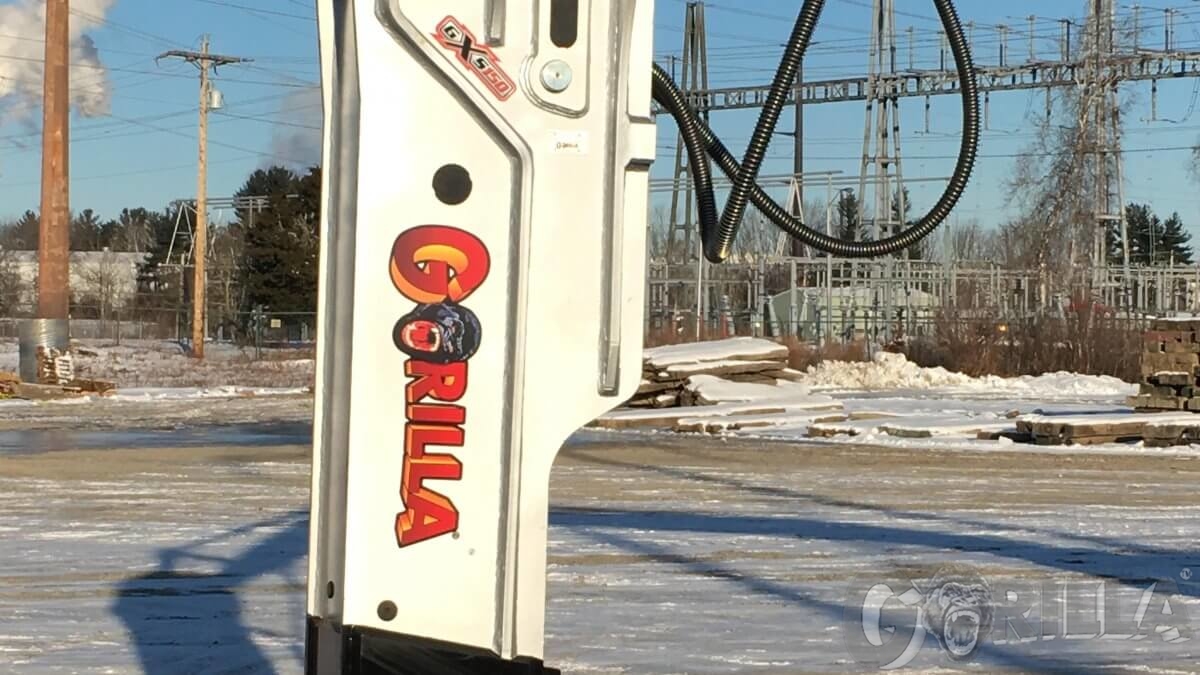
Troubleshooting Issues With Hydraulic Hammers
February 27, 2020
How to Extend the Life of Your Hydraulic Hammer
July 9, 2020Hydraulic hammers, also known as hydraulic breakers and hoe-rams, are a useful tool for many different applications. They can be used for demolition, excavation, removal of slag and cleaning pots in steel mills, and even driving steel or wooden fence posts. Depending on their size, they can break through anything from reinforced concrete, to giant boulders to embedded ledge, granite, and bedrock. There are many different types to choose from, which can make it seem like a complicated decision, especially if you’re not familiar with the different attributes of a breaker. Here are three things to take into consideration when you’re renting or buying a hydraulic hammer for your next project!
Match the hammer to the job
Hydraulic hammers are used for a variety of different applications, so finding the equipment that best matches the intended project is key. If the hydraulic breaker is too small for the job, it will not break efficiently, likely overheat and cause the operator to compensate by running the breaker on the same spot on the material for too long(move than 20 seconds), or using it to pry or peck at the material. This will result in expensive broken tools and frequent repairs. The hammer is limited by the carrier you are using, so once you figure out the impact level you need to break through the material within your time frame allowed, choose a carrier that will accept the proper breaker for the job. As a rule of thumb, if the breaker is consistently moving through the material on each strike as it cycles, you do not need anymore. If a 5,000 ft-lb breaker on a Komatsu PC200 is consistently moving through broken oversized rock on each downstroke with only a few strikes, it will use less fuel, will likely be cheaper to move from job to job via trailer or lowbed, and will be easier for an operator to move from boulder to boulder than a heavier Komatsu PC300 with an 8,000 ft lb breaker. In practice, given the variety of jobs most demolition, excavation and site contractors face, they purchase the largest breaker their carrier can safely carry and properly supply oil to as they would rather have the most impact power ready to go and avoid rentals.
Match the hammer to the carrier
Selecting the right size hydraulic breaker for your skid steer, mini-excavator or full-sized excavator crawler carrier is crucial, both for optimizing efficiency and protecting the equipment. Your carrier’s limitations regarding the size of hydraulic hammer you use come down to its tonnage, or operating weight, and oil output, discussed below. In short, your carrier has to be large enough to safely carry the hammer at all angles and extensions of the boom and stick without “tipping” the carrier or “diving” too much when the hydraulic hammer breaks through the material being demolished. A hammer that is too heavy for the carrier will also limit the operator’s ability to efficiently lift the hammer, and move across the material to be broken. This is especially important when breaking hard, rounded and unevenly shaped rock where the operator must move often to find fissures, weak spots, and striking points. The carrier also has to be large enough to withstand the recoil that all hydraulic hammers transfer back to the carrier as they are operating. Too much recoil can result in the carrier’s hammer supply pipes and clamps to loosen, and affect the weldments on the carrier itself-not to mention increased operator discomfort.
Aside from controlling oil output as discussed below, the hydraulic breaker cannot be too small for the carrier either. Each carrier exerts down-pressure on the hydraulic hammer as it is planted on the material to be broken. If the hammer is too small, excessive down-pressure will cause its frame to twist, fasteners to loosen up or break more frequently and weldments to crack.
Match the carrier’s auxiliary hydraulic system to the breaker
As it sounds, hydraulic hammers are powered by the hydraulic flow of excavators. Despite what many hammer companies will tell you to snatch a quick sale, all hammers require that they receive oil from the carrier within their specific operating range. Otherwise, why would every spec sheet for every hammer ever made provide those values in their sale brochures?
For a hydraulic hammer to maximize its life and efficiency while putting as little strain on the skid steer, mini-excavator or full-sized crawler excavator’s hydraulic system as possible, the carrier must be set up to deliver oil to the hydraulic breaker at the correct volume, pressure, and relief without exceeding the backpressure limitations of the hammer. Too much oil or pressure will cause the hammer to overspeed, reducing seal life and damaging internal components. Improperly set relief or excessive backpressure can cause overheating of the breaker and the carrier’s hydraulic system. Too little oil flow will not only reduce the breaker’s impact power but can also cause damage to internal components from an inability to provide a lubricating film between internal moving parts.
Most carriers have adjustable hydraulic systems to perform this fine-tuning, but a qualified hydraulic technician with the proper flow meter to measure all of the hydraulic values simultaneously throughout the operating range is the only way to optimize your hydraulic breaker’s performance and protect your carrier.
Gorilla Hammers Can Help!
No one knows hydraulic breakers better than us. With more than 75 years of experience in the industry, we fully understand the need for hydraulic hammers for demolition, construction, and excavation. Our hammer equipped excavator rental fleet gives us the opportunity to field test and continually improve our Gorilla Hydraulic Breakers™. Our hammer shop repairs well over 100 hydraulic hammers each year and supplies parts and demolition chisels, blunt and moil tools to contractors throughout the country. Our Gorilla Hammer Advisors ™ are always ready to help you match the right hammer for your carrier. It only takes about five minutes but will ensure peak efficiency while maximizing hammer life and minimizing downtime. Get in contact with us today at 888-81-GORILLA(46745) to determine which hydraulic hammer you’ll need!




